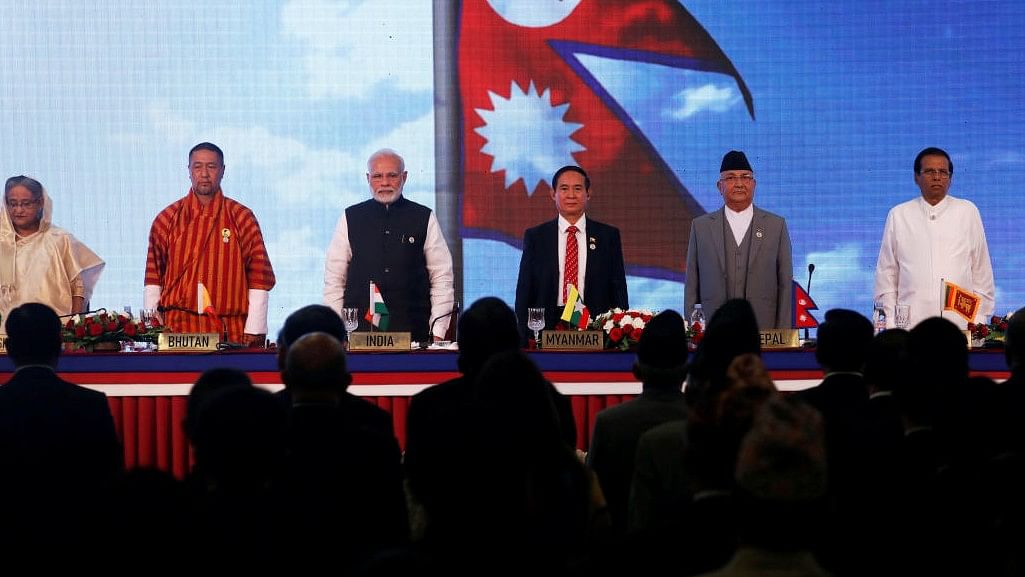
File photo of members of BIMSTEC heads of state attend the summit in Kathmandu.
Credit: Reuters File Photo
Recently, tumultuous developments have changed governments in Kabul, Yangon, Colombo, Malé, Islamabad, Kathmandu, and Dhaka. While many factors, domestic and external, played a role in these dramatic changes, they demonstrated the urgency of meeting citizen aspirations. They also exposed the challenges for India in her neighbourhood.
Big countries often face challenging, sometimes difficult, relations with neighbours, who may be relatively small but seek greater diplomatic space.
Traditionally, India’s neighbourhood was defined by geography, civilisation, values, and diversity. New lines drawn during the retreat of colonial powers created fissures that old societies, but new countries, had to contend with.
Since Independence, versions of a neighbourhood first policy have been in effect. Good neighbourly relations were a priority, but episodes of conflict, terrorist attacks, and regime change contributed to turbulence; often national security, development cooperation, or citizen interaction were casualties.
India as the largest power in the region was expected to be benevolent but was not necessarily viewed as a role model. Indeed, certain neighbours sought to expand diplomatic space by playing India off against external powers. When development yielded per capita income or social indicators better than in India, their attention wandered. India's strategic perspectives and geo-political location also brought the attention of external powers to the region.
South Asian identity did not garner the desired momentum, unlike in many other regions. There was a trust deficit, partly due to legitimate security concerns and partly due to weak political communication, and bipartisan support was not fully realised. Consequently, regional integration suffered and institutions such as SAARC and BIMSTEC faltered in their objectives.
The regional landscape and geopolitical flux added to uncertainty. For regional stability and prosperity, there is a need for review to develop mechanisms that promote trust and confidence, optimise benefits and address new and emerging challenges.
Embrace Dharma (Righteousness): India’s size and democratic experience call for a balance between values and principles of righteousness and national interests. Neighbours must have confidence regarding the pursuit of the common good. Non-reciprocal benefits and non-transactional relations promote trust, long-term mutual benefit, autonomy, and diplomatic space.
Advance Samvaad (Dialogue): The absence of dialogue and consultations takes neighbours further apart, while engagement with stakeholders promotes trust, appreciation of national priorities, and negotiated outcomes. Special attention is needed to generate bipartisan political consensus and to align with economic and youth aspirations.
Promote Sakshamta (Capability): South Asia needs economic growth such that prosperity can reach all. Our Gen Z is aligned with global trends and seeks improvements in quality of life and opportunities in the developed world. Our governance platforms need to enhance the capacity and capability of our citizens, excessive reliance on external sources could be detrimental.
Align Niti (Policy): In an era when global supply and value chains are closely aligned, South Asia suffers from a deficit of intra-region integration. There is a need for policy coordination to build connectivity infrastructure, harmonise flows of goods, services, and investments and stimulate institutional and people-to-people exchanges.
Forge Aikyam (Unity): While South Asia shares similar experiences and heritage, countries also have their aspirations and perspectives. Bilateral and regional initiatives that address the comfort zones of neighbours can enhance trust and cooperation. Celebration of regional achievements is integral to the establishment of regional identity and lends confidence when dealing with external forces.
South Asia can take advantage of a favourable situation in economic development and youth empowerment, to position herself confidently in the emerging knowledge-based order through the pursuit of dharma, samvaad, sakshamta, niti, and aikyam.
(The writer is a former diplomat and Professor of Diplomatic Practice at OP Jindal Global University. Views are personal)